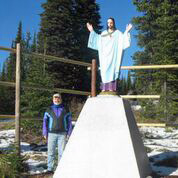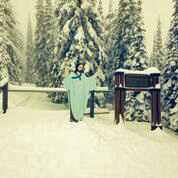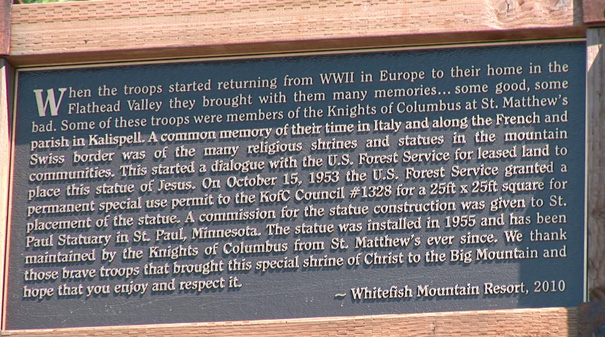Atheists Attack “Big Mountain Jesus” Memorial to Fallen American WWII Soldiers
Long-Standing Statue of Jesus Honors Memory of Soldier-Skiers Who Fought in World War II

Near Glacier National Park, this hardly seems a place where a battle goes on over a statue called “Big Mountain Jesus.”
The statue has stood on a tiny 25-foot-by-25-foot piece of leased land high up on the mountain for over 60 years as a memorial honoring soldiers of the 10th Mountain Division who lost their lives fighting in the Alps of Italy.
But it has somehow “offended” a group of atheists who want it removed. The tiny parcel is leased by private citizens, like parts of the ski area itself by the resort, from the U.S. Forest Service. One of the group’s members no longer feels able to ski there because the statue is somewhere on the mountain.
The atheists threatened to sue the Forest Service because it was renewing the permit for the monument every ten years, without ever an incident. At first the Forest Service buckled and denied the permit when time came to renew.
But people didn’t take it sitting down. Thousands of letters and petitions poured in to leave the Big Mountain Jesus statue where it was.
Winning Round One
The atheist foundation from Wisconsin, the Freedom from Religion Foundation, did sue. In 2013 the Becket Fund successfully defended Big Mountain Jesus. The United States District Court for the District of Montana, Missoula Division, ruled in favor of the Forest Service and local Knights of Columbus and dismissed the case. But the atheists appealed to the Ninth Circuit Court of Appeals.
In the first week of July 2015, the Becket Fund defended the statue once again before the court.
Eric Baxter, senior counsel of the Becket Fund for Religious Liberty, said the appeal wasn’t a huge surprise since the militant atheists go after any sign of religion in the public square and want it censored.
Why Jesus on the Big Mountain?
“The real motivation for the statue is to honor the soldiers from the 10th Mountain Division who fought during World War II,” said Raymond Leopold who is one of the Knights of Columbus who volunteers to care for the statue and sees its significance as this memorial. He is also one of the four intervenor-defendants in the case.
“It’s high time we don’t let ourselves be battered around by other people, these zealous types,” he said in the spirit of the men from the 10th Mountain Division. “We’re saying we have rights too. We have freedom of expression.”
Leopold is a graduate of the Air Force Academy where he later was an associate professor, and he also worked at the Pentagon.
Formed in nearby Kalispell, Montana in 1908, the Knights of Columbus Council No. 1328 raised money for the statue, got the permissions, and put it up in 1954. They were recruited by the originator of the idea — the late Ed Schneck, the co-founder of Big Mountain Ski Resort in 1947.
“My father was one of the earliest members of the national ski patrol,” his son Carl told me. “He joined the 10th Mountain Division, was sent to Officer Candidate School, and all he wanted to do was be in the 10th Mountain but ended up in 82nd Airborne and fought in Italy [and other places]. His brother Aaron joined the 10th.” Another brother died in the Battle of the Bulge.
History Plays Major Part
Carl Schneck and Baxter elaborated on how the 10th Mountain Division was formed to fight in the Alps. Many of the earliest of skiers in pre- and early World War II days were recruited to join this new division.
“Some of the original skiers who skied back in the 1930s did join the 10th Mountain,” Carl explained.
“It was a highly specialized group of soldiers,” Baxter noted. They had the skills to fight on show-covered mountains.
In Italy, on every hill and mountain they captured or encountered, they always found a statue. It became a real part of the 10th Mountain’s experience.
The division became its campaign in Italy in early January 1945, and by May 2 when the war in Italy ended, the division suffered 25% casualties — 975 killed and 3849 wounded.
When Ed Schneck came back and on Big Mountain founded one of the country’s earliest ski resorts, he never forget his fallen comrades. It’s worth quoting Big Mountain’s former manager, Bill Martin, which the Montana U.S. court did in its 2013 favorable decision:
“He [Ed] was an avid skier and skied on many of the slopes in Italy. He remembered that almost all of the slopes in Italy had statues of Christ on the slopes. More than one on several slopes, and also other statues and crosses. When Ed returned to Whitefish after the war…He had such an admiration of the Christ statues that he had observed on the slopes in Italy during the war, that he wanted to install one on Big Mountain in memory of the men who had lost their lives in WWII. Somehow he contacted the local Knights of Columbus in Kalispell and asked if they would participate in getting the statue installed…I can remember that the statue was installed in memory of the veterans who Ed had served in WWII, and he wanted it dedicated to them.”
Carl Schenck said that as long as he remembers the statue has been there. “I love the statue. We’re about the same age.”
He also described how quite a few members of the Knights skied and and how veterans helped construct the first ski lift and lodge.
“This tells us a great story,” Baxter said of Ed Schneck and the others. The monument tells a great story about who the men were. Soldiers used their war experience to help build a positive industry once back in the U.S. They started the ski industry and wanted to honor their comrades on the ski slopes. “That’s why the monument shows the transition of Whitefish into a ski resort.”
The 10th Mountain Division itself notes: “Veterans of the World War II 10th Mountain Division are often credited with founding the modern American ski industry.” For over 60 years the statue has been an important part of the area’s history. In 2011 when the first suit was filed, Whitefish Mountain Resort CEO Dan Graves told a local paper, “It has a whole lot of historical value. When you take into context the time it was put up — the vets’ lives and what they went through — it’s a rich part of our history.”
Then in 2012, Graves also said he “was a little outraged and I think many people were…It seems like they are trying to take away not only a piece of history here on mountain and in Montana but also try to tell us how to live and what values we should or should not have.”
Real Irony Abounds
At the time the monument was installed in 1954, it was above the ski area which has expanded to the top of the nearly 7,000-foot mountain. Still, Big Mountain Jesus by Leonard’s estimate is well about the 5,500-foot level.
“I skied up here several times and I never saw it,” Leonard explained about his early experiences on the mountain when he didn’t realize it existed. “You’ll find people don’t generally even notice this. Even people who ski there miss it when skiing.”
Carl Schenck agreed. “You have to go find it. It’s not in anybody’s way,” he said. He noted it’s a place local skiers might use as a place to meet. During the ski season the 6-foot high pedestal gets covered with snow, but the 6-foot tall statue of Jesus remains visible.
Schneck described his own later military experience: “I served in Italy for 3 years and they’re right about going up on top of mountains and seeing statues there.”

The U.S. District Court opinion also agreed, stating that because the statue “remains largely obscured by trees; one would have to ski out of their way and off the main runs in order to directly encounter Big Mountain Jesus. In fact, unless one was specifically looking for it, it is possible to ski at Big Mountain day after day and never encounter the statue.”
The court stated that “over the course of the last 60 years the statue has become more of an historical landmark and a curiosity.”
Riley Polumbus, spokesperson for Whitefish Mountain Resort, also weighed in. She told me the statue has a beautiful location facing gorgeous views of Flathead Lake and the valley but it is “kind of hidden.”
“You have to be an intermediate skier to even get to the statue,” she said. And in the summer it’s even less visited since there is no formal trial leading there. There is a service road but that can be used only with permission.
The reaction from those over the years who know about or come upon the statue?
“Once our guests find the statue they love it,” Polumbus said. “It’s something they go back to every year. They take pictures with it, or put skis and poles next it to make it into a skier. The locals understand the story behind it — to honor the troops in World War II.”
Ironic to think this is an unconstitutional endorsement of religion.
The Outlook
“There’s no reason for the court to strike this monument down,” Baxter said. In fact, if the Knights were targeted because it has a religious aspect, that would be discrimination against the Knights of Columbus because of their speech.”
In fact, the 2013 court already wrote the monument is “reflecting the personal views of its private owners and therefore cannot be seen by the reasonable observer as reflecting government promotion of religion.”
Baxter pointed out a whole range of monuments in this same circumstance, dedicated even to various canoers, big horn rams, firefighters, and forest rangers — subject to the same permitting.
“So if the forest service allowed those to stay and made the Knights remove theirs,” he said, “that would violate the first amendment on the basis of speech.”
In the spirit of the men from the 10th Mountain Division, Leopold stressed, “It’s high time we don’t let ourselves be battered around by other people, these zealous types. We’re saying we have rights too. We have freedom of expression.”
As they wait for this next court decision, Leopold and others remain cautiously optimistic. “We’re looking for all the support we can get — mainly in the form of prayers,” he said. “Let’s work within the political process to make America the country we know it should be.”














